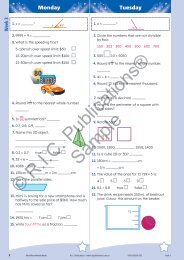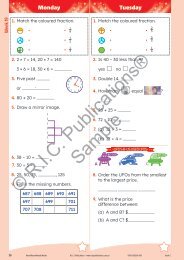You also want an ePaper? Increase the reach of your titles
YUMPU automatically turns print PDFs into web optimized ePapers that Google loves.
Subtropical climate <strong>zones</strong><br />
Lesson objectives<br />
XXIdentifying the location of countries that experience a subtropical climate and their proximity to majors lines of latitude<br />
XXExamining climate data from five cities in the subtropical climate <strong>zones</strong> to identify similarities and differences between<br />
countries with arid and Mediterranean climates<br />
Lesson plan<br />
Introduction<br />
XXGo to and click on the map of the<br />
world to display the four major climate <strong>zones</strong>. Discuss the location of<br />
the subtropical climate <strong>zones</strong> in relation to the major lines of latitude.<br />
In pairs, students use Google Earth and a note-taking app (Notes) to<br />
list as many countries that lie in the subtropical <strong>zones</strong> as possible in<br />
five minutes.<br />
Development<br />
XXDivide the class into groups of five, and allocate one city to each<br />
student—Phoenix (USA), Madrid (Spain), Rome (Italy), Riyadh<br />
(Saudi Arabia) and Tripoli (Libya). Individually, students research<br />
characteristics of arid and Mediterranean climates and record key<br />
information using the T-chart on page 29. They then scan the QR<br />
code or use the URL to research climate data for their allocated city.<br />
Students draw conclusions from their research to predict if their<br />
allocated city has an arid or Mediterranean climate.<br />
XXAs a class, establish an inside-outside circle where students briefly share the climate data for their<br />
allocated city and discuss which climate type they think the city<br />
has. Students explain their reasoning and discuss any differences in<br />
opinion.<br />
XXIn pairs, students use a puppet show app (Sock puppets) to create a<br />
scene with two characters—one that lives in an arid climate and one<br />
that lives in a Mediterranean climate. Each student pretends they<br />
are one of the characters and together they role-play a conversation<br />
about the weather and climate in their city, and why they like living<br />
in that climate. Students should provide climate data during the<br />
conversation.<br />
Conclusion<br />
XXIn pairs, students use Google Earth to locate the five cities listed on<br />
page 29 and compare their locations to the major lines of latitude.<br />
Students examine the location of cities they believe have an arid<br />
climate and discuss the colouration on the map in each country,<br />
then repeat for cities they believe have a Mediterranean climate.<br />
Students discuss the question Does vegetation grow in both arid and<br />
Mediterranean climates? and explain their reasoning.<br />
Resources<br />
XXWorld map—four major climate <strong>zones</strong><br />
<br />
XXiPad ® /tablet with QR scanner, a<br />
note-taking app (Notes) and a<br />
puppet show app (Sock puppets)<br />
XXPage 29<br />
XXGoogle Earth<br />
XXInside-Outside circle explanation<br />
<br />
As a class, watch the<br />
video Living in the desert<br />
at .<br />
Travelling further<br />
Would you continue to live in<br />
the desert if your family had<br />
lived there for generations?<br />
Research climate data in the<br />
Sahara desert and discuss.<br />
Students write a letter to<br />
their family explaining their<br />
decision based on climate<br />
data for the Sahara desert.<br />
Curriculum links<br />
HASS Knowledge and Understanding<br />
The main climate types of the world and the similarities and differences between the climates of different places<br />
(ACHASSK068)<br />
HASS Inquiry and Skills<br />
Questioning Researching Analysing<br />
Evaluating and<br />
reflecting<br />
Communicating<br />
• Locates and collects<br />
information from Google<br />
Earth and websites<br />
• Records, sorts and<br />
represents data using a<br />
note-taking app, a T-chart<br />
and a table<br />
• Interprets cartographic<br />
information to locate cities in<br />
subtropical climates and<br />
• Compares the colour-coding<br />
on a map to identify patterns<br />
between the vegetation in arid<br />
and Mediterranean climates<br />
• Draws simple conclusions<br />
about the weather, climate and<br />
vegetation in places located within<br />
the subtropical climate zone<br />
• Interacts with others with respect<br />
to share points of view about the<br />
climate type of different cities<br />
• Communicates<br />
understanding using an<br />
inside/outside circle and a<br />
puppet show app<br />
28Y<strong>Year</strong> 3A AC GLOBAL GEOGRAPHYw www.ricpublications.com.auI


















